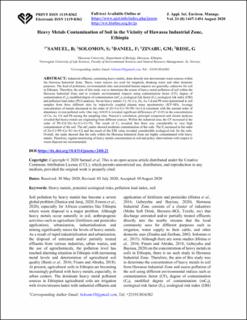| dc.description.abstract | Industrial effluents, containing heavy metals, drain directly into downstream water sources within the Hawassa Industrial Zone. These, water sources are used for irrigation, drinking water and other domestic purposes. The load of pollutants, environmental risks and potential human impacts are generally, unknown for soil in Ethiopia. Therefore, the aim of this study was to determine the extent of heavy metal pollution of soil within the Hawassa Industrial Zone and to evaluate environmental impacts using contamination factor (CF), degree of contamination (Cd), modified degree of contamination (mCd), ecological risk factor (Er), ecological risk index (ERI) and pollution load index (PLI) analyses. Seven heavy metals: Cr, Ni, Cu, Zn, As, Cd and Pb were determined in soil samples from three different sites by inductively coupled plasma mass spectrometry (ICP-MS). Average concentration of metals decreased in the order of Zn>Cu>Cr>Ni>Pb>As>Cd consistent with the normal order of abundance in non-polluted soils. One way ANOVA revealed significant differences (P<0.05) in the concentrations of Cu, As, Cd and Pb among the sampling sites. Pearson’s correlation, principal component and cluster analyses revealed that heavy metals are originating from different sources. Within the industrial area, the CF increased in the order of Pb<Cd<Zn<As<Cu<Cr<Ni. The result of Cd revealed that there was considerable to very high contamination of the soil. The mCd index showed moderate contamination of the soils. The Er increased in the order of Zn<Cr<Pb<Cu<Ni<As<Cd and the result of the ERI value revealed considerable ecological risk for the soils. Overall, the study showed that the soils within the Hawassa Industrial Zone are highly contaminated with heavy metals. Therefore, regular monitoring of heavy metals concentration in soil and policy interventions with respect to waste disposal are recommended. | |
